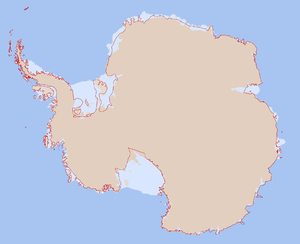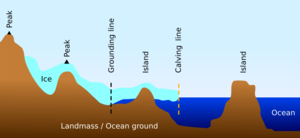Antarctica/Import 2013
This page contains some notes and plans for importing data for Antarctica and for facilitating future community mapping of the continent. It summarizes some of what has been discussed in blogs here and here.
These plans have been discussed at the Karlsruhe_Hack_Weekend_February_2013 and a tagging scheme for the Antarctica specific features has been developed that can be found on Antarctica/Tagging.
Situation before the import
At the moment (February 2013) the representation of Antarctica in Openstreetmap is fairly basic:
- There is a coastline based on GADM, which is not very detailed and contains various larger errors. Some edits have been made to this afterwards but none of them seems to fix the basic problems. This coastline does not include the ice shelves, it is drawn at the grounding line.
- The land ice data is fairly arbitrary, for most parts the whole mainland mass is tagged as natural=glacier while the islands are ice free. Few manual edits near McMurdo Sound are not very detailed.
- A few research stations, air fields and various point features are mapped.
- Most data (esp. the coastline) is limited to the Mercator projection area (i.e. it only extents to 85.0511 degrees south).
In the map on the right you can see the current OSM coastline as a thin red line and the proposed import in beige and light blue.
General considerations
Since Antarctica is quite different from other areas on earth there are a few general questions that probably should be discussed before an import or large scale community mapping:
Map projection
- See also Antarctica/Creating_a_map
Mapping in the normal OSM Mercator projection excludes the southernmost part of the continent. But even further north map distortion can be a serious problem. Using Polar Stereographic (EPSG:3031) projection would be a logical choice. Support for this in common editors would be a great advantage for Antarctica mapping. JOSM supports plate carrée (EPSG:4326) and thereby allows formally dealing with data up to the pole, for example for imports but practical manual editing this way would be a very bad idea. An alternative is to do the actual mapping in a separate program supporting other projections (like Quantum GIS), convert it to EPSG:4326 and upload it using JOSM.
There are some issues that could cause problems with use of varying coordinate systems during mapping as outlined in a blog post.
Rendering in polar stereographic projection - although being optional for the mapping itself - would probably much help Antarctica mapping efforts. Initial tests have shown that rendering in Polar Stereographic using Mapnik is feasible - a map demonstrating that can be found on [1]
Land features and Tagging
Import plan
Due to the low quality of the existing coastline data the current plan is to replace it with an import from MOA. This source also include data for the ice shelves. The inside of the coastline would default to natural=glacier replacing current glacier data (except for some on islands at the Antarctic peninsula where glaciers have been mapped in more details - otherwise ice on antarctic islands is currently not mapped at all). There is also a small section of coastline at McMurdo Sound which is mapped in more detail based on LINZ data as well as two small sections on King George Island (one with a serious offset though). This will need to be merged with the data to be imported. All other features currently in OSM would be unaffected although their position could require updating (like when a research station at the coasts turns up above water with the new data).
Purpose of this would be to bring the Antarctica coastline to the minimum level of accuracy comparable to elsewhere in OSM coastline data and to create a uniform quality starting point for following mapping activity which could for example be based on LIMA.
The MOA data is derived from satellite imagery with a nominal resolution of 125m so the resolution of the derived coastline data is similar. There are however errors of up to several kilometers in some places due to wrong classification of the images. This is still better than the existing OSM data. Other, more detailed data exists but is not available under license conditions compatible with OSM.
The original MOA coastline from NSIDC is poorly vectorized and needs to be reprocessed before an import. An example for a processed version (with coastline at the outer shelf ice edge) can be found on [2] - this will need to be combined with the shelf ice data.
Data preparation
The following data sets have been produced from the MOA coastline data set for import into OSM. Data preparation is going to consist of the following steps:
- Rasterization of the MOA data into the original 125m grid (done)
- Vectorization of the different surface types (land, ice shelf, water) using potrace (done)
- Combination of the different polygons into a consistent vector data set (done)
- Production of line data sets for the different lines according to the tagging scheme (done)
- Reprojection into EPSG:4326 (done)
- Conversion into OSM format using modified Ogr2osm (see below) (done)
- Manual fixes for smaller errors using JOSM
The data sets:
- [3] This contains a bunch of GeoJSON files and two QGIS projects. Version 3 from March 2
- [4] OSM conversion created with a modified version of Ogr2osm allowing to tag the boundary ways of the multipolygons
Known issues are:
- The MOA data set contains several smaller inconsistencies, in particular places where the grounding line is outside the coastline and where islands are inside the coastline. Both are ignored during processing (i.e. the coastline data takes priority).
- There are many very small ice shelf areas of just a few pixels in the MOA data. The very smallest of those (<=5 pixels in the original grid) have been removed in the latest version since on spot inspection most of them seem to be artefacts.
- There is a water polygon which is necessary during processing but of course will need to be removed before import (has already been removed in the OSM file).
There are some minor problems at the 180 degree line that need to be fixed- fixed except for two duplicate nodes at -89 deg latitude - those will not be in the imported data since the coastline is not going to be closed- There is a multipolygon for the main land mass tagged place=island that should not remain for the import
- Long ways >2000 nodes are not yet split (there are only 11 of those though)
The ways are going to be tagged source=http://wiki.openstreetmap.org/wiki/Antarctica/Import_2013 for the import.
The manually modified data can be downloaded for review from [5]. The following manual modifications have been made:
- Removal of the main land mass multipolygon
- Removal of duplicate nodes at -89 deg latitude (the closing way for the coastline is still left in, removal is subject to discussion on dev@openstreetmap.org)
- Splitting of the long ways >2000 nodes
- Removal of the islands not connected to the ice shelves for the first import step (see below)
- Removal of the coastline segments at McMurdo Sound/Ross island where better data already exists
- Tagging ice shelf segments that are to be replaced with existing data with 'fixme'.
Everyone is invited to review this file before the planned upload next weekend
Import procedure
As outlined above most of the existing Antarctica data in OSM will not interfere with the import. The actual import is planned to be done in the following steps. As you can see we plan to separate the import of data for the main land mass and everything collected to the ice shelves from the import of data for the separate islands. These steps will be done using a separate user account (MOA import) only used for this one import.
- Preparation (can be done separately some time before the import)
- Creating nodes place=island with name and other tags for all islands currently tagged at the outline way only.
- Re-tagging coastlines segments that are not going to be replaced during import for the main Antarctica land mass with the new tagging scheme and splitting the ways as needed for merging with the new data (only McMurdo sound area and Ross island).
- Manual editing of the import data: removing those coastline segments where existing data is to be kept, fixing remaining problems from list above. This manually post processed import data set will be made available to those interested for inspection.
- Main coastline import - to be done in JOSM in one editing session, the import data (see above) and the current OSM data (from up-to-date Geofabrik extract) will be loaded as different layers.
- Removing the main ice sheet multipolygon
- Removing all coastline segments to be replaced by the new data
- Transferring the import data to the OSM layer
- Merging nodes at the edges with existing data
- Adding existing ways to ice shelf multipolygons
- Converting one existing inner ring of the main ice shield multipolygon to a natural=bare_rock area
- Uploading the data
- Fetching the new data using Overpass_API, manual inspection and verification of coastline consistency using OSMCoastline
- Ice shelf islands post processing (if time permits immediately after the previous step)
- Transferring island names of ice shelf islands from nodes to the new areas
- Antarctic islands data import (does not have to be done all at once)
- Import new coastline data island by island merging existing data as necessary while verifying its accuracy. This might take some time since some of the current OSM data on the islands that has been improved from GADM contains serious offset. This step can be done for each island individually without problems. We will try to first import the uncritical islands (where there is no existing data to be kept).
- Transfer island names from nodes.
- Manual mapping of those islands missing in the new MOA data but present in the old GADM data. This in not actually part of the import of course but will be the final step to fully replace all GADM data in Antarctica.
Import progress
- Preparation: done - see above and [6]
- Main coastline import: done, see [7] [8] [9] [10] [11]
- Ice shelf islands post processing: done, see [12]
- Antarctic islands data import: done, except for South Shetland Islands and South Orkney Islands, see [13]
- Manual mapping of those islands missing in the new MOA data: todo
After the import
Following the import or parallel to it the following steps would be important for future community mapping of Antarctica:
- support in renderers for shelf ice and ice as default land cover
- support in editors for polar stereographic projection
- support in renderers for polar stereographic projection and setting up web maps using it
- setting up satellite imagery for use as data sources for manual mapping
- investigating other data sources for possible import (like the LINZ data listed on Antarctica)
All of these would also be useful for mapping the northern polar region.

